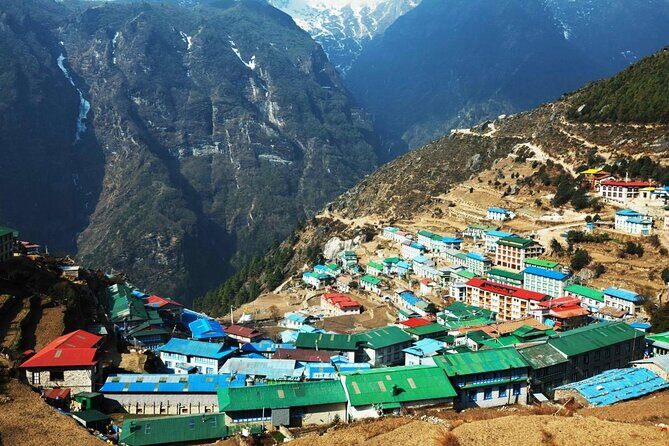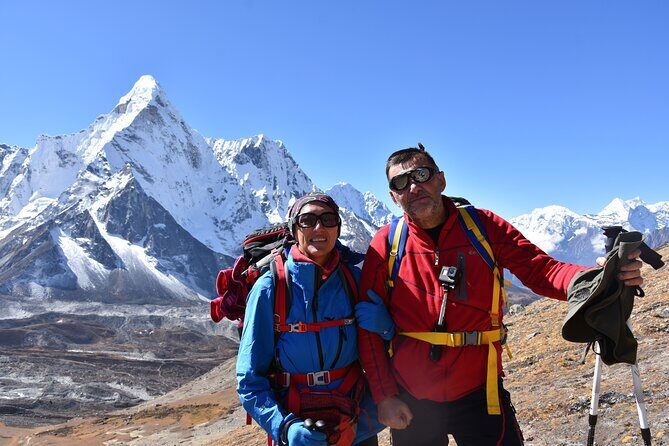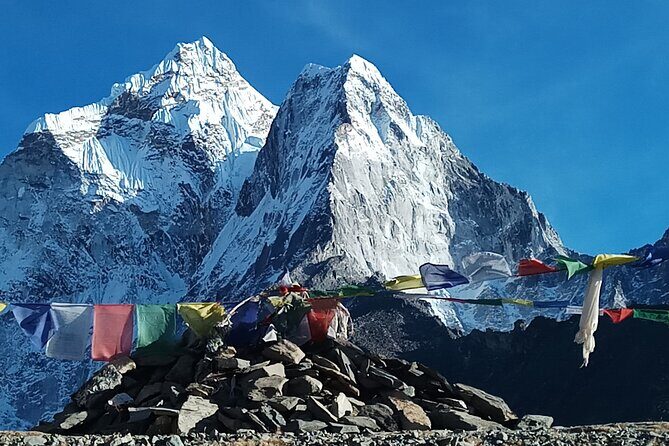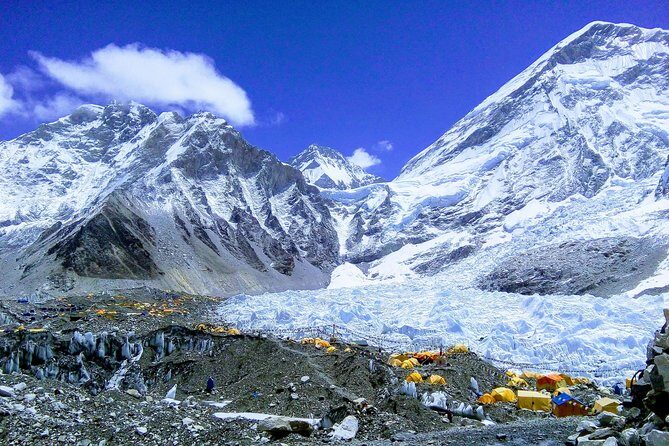Planning a trek to Everest Base Camp is no small feat, but if you’re looking for a well-organized, authentic experience that balances comfort with adventure, this 12-day tour might just be your best bet. Starting in Kathmandu, flying to Lukla, and traversing through iconic villages like Namche Bazaar and Tengboche, this trip guides you through some of the most breathtaking mountain scenery on the planet. The package includes domestic flights, teahouse accommodations, tasty local meals, and experienced guides, making it a comprehensive and hassle-free way to stand at the foot of the world’s highest peak.
What we love most? First, the all-inclusive nature eliminates the usual stress of organizing permits, transport, and accommodations on your own. Second, the well-paced itinerary allows for proper acclimatization, helping you enjoy the scenery without rushing or risking altitude sickness. A minor point to consider is the dependence on weather conditions, particularly the flights to and from Lukla, which can be delayed or canceled. This trek suits travelers who want a genuine mountain experience without sacrificing comfort and who appreciate skilled guidance along the way.
Key Points

- All-inclusive package simplifies the logistics of trekking to Everest Base Camp
- Experienced, licensed guides help navigate high-altitude routes and cultural sites
- Comfortable teahouse accommodations with meals included make the journey manageable
- Flexible itinerary with acclimatization days ensures better health during the trek
- Flight between Kathmandu and Lukla streamlines travel, but weather can impact schedules
- Perfect for adventurous travelers seeking a balance of comfort and challenge
An In-Depth Look at the Everest Base Camp Trek Experience

Love the outdoors? Here are other hiking experiences we've covered in Kathmandu
Starting in Kathmandu: The Gateway to the Himalayas
Your journey begins with a pickup in Kathmandu, a city bustling with culture, colorful markets, and ancient temples. The organized nature of this tour means your airport transfer is taken care of, allowing you to focus on the adventure ahead. After a short flight of about 40 minutes to Lukla, you’ll be greeted by your guide and fellow trekkers, setting the tone for a supportive group experience.
The First Steps: From Lukla to Phakding
The trek kicks off with an early morning flight—a highlight in itself—offering stunning aerial views of the Himalayan ranges. After landing in Lukla, you’ll meet your crew, and the trek begins. The first walk to Phakding (around 4 hours) is gentle, giving you time to acclimate and soak in the scenery. Along the way, you’ll get your first glimpse of Mt. Khumbila, a sacred, untouched peak, visible from Cheplung village. The trail follows the Dudh Koshi River, with lush forests and rustic villages setting a peaceful tone.
Navigating Through Sherpa Villages and Sacred Sites
The route from Phakding to Namche Bazaar (about 5 hours) is perhaps one of the most iconic sections. Crossing suspension bridges over roaring rivers and climbing through pine forests, you pass through Jorsale and cross the entrance to Sagarmatha National Park. Here, the scenery shifts — mountains loom larger, and the cultural richness of Sherpa villages becomes evident. Namche is a lively hub, full of shops, tea houses, and a vibrant market atmosphere.
Acclimatization and Cultural Highlights
One of the tour’s strengths is the dedicated rest day in Namche. This is crucial for acclimatization, allowing your body to adjust to higher elevations. You can explore the town, visit the Sherpa Museum, or hike up to the Syangboche Airstrip for panoramic views. The mornings offer a chance to enjoy spectacular sunrises over peaks like Lhotse, Nuptse, and Ama Dablam. This is also a chance to observe the mountain life and learn about Sherpa traditions.
Into the Heart of the Himalayas: Tengboche and Dingboche
Leaving Namche, the trek continues with a gradual climb towards Tengboche, home to the renowned Tengboche Monastery, the largest in the Everest region. Perched atop a ridge, it offers dramatic views of Everest, Nuptse, and Ama Dablam. If you arrive by 3 pm, you might witness a Buddhist ceremony, adding a spiritual dimension to the experience.
Next, the route descends into Imja Valley, passing through Pangboche and the Pangboche Monastery. As you move to Dingboche, you’ll notice the change in landscape—barren, rocky, yet stunning. Spending a night here helps with altitude acclimatization. Many travelers enjoy hiking up to nearby hills, where views of Everest, Lhotse, Makalu, and Cho Oyu are simply breathtaking.
Approaching Everest: Lobuche, Gorak Shep, and Base Camp
The challenge escalates as you trek towards Lobuche, a mountain village with spectacular mountain vistas. The next day, you’ll tackle the long hike to Gorak Shep, your base for reaching Everest. After a hearty lunch, you’ll walk to Everest Base Camp, where the towering Nuptse and Khumbuste peaks frame the scene. The views here will stay with you — a true highlight.
The trek’s most iconic moment comes at Kala Patthar, the highest point on the journey at about 5,555 meters. It offers unmatched panoramic views of Everest and surrounding giants. Climbing up takes about three hours, but the effort is worth every step. Many reviews highlight this as a life-changing view, with one careful trekker noting that, “We loved the way the sunrise hit Everest from Kala Patthar.”
Descending and Reflecting
The return journey is just as scenic, retracing routes through Dingboche, Tengboche, and Namche. The descent is often easier physically but no less spectacular. The last stretch from Lukla back to Kathmandu is a bittersweet moment—reflection on the journey and the accomplishment of reaching Everest’s doorstep.
Practical Details: Transport, Accommodation, and Permits
The domestic flight between Kathmandu and Lukla is a highlight but can be unpredictable due to weather. The tour covers this, along with permits and paperwork, making logistics stress-free. Accommodation is in teahouses—basic but comfortable, with warm beds and hearty meals. The tour also includes porter services (a ratio of two trekkers per porter), meaning you won’t have to carry heavy loads.
What the Tour Includes and Excludes
The package offers excellent value, including all necessary permits, guides, meals, transportation, and flight tickets. Extras like visas, personal expenses, or additional nights in Kathmandu are not covered but are easily arranged. Travelers have praised the knowledgeable guides who help with altitude, culture, and safety, making the journey smoother and more enriching.
The Experience Through Traveler Reviews
Multiple reviewers have spoken highly of the guides’ expertise and the genuine connection to local culture. One wrote, “The warmth and resilience of the mountain people, coupled with the breathtaking landscapes, helped us to discover a new adventure.” Others appreciated delicious meals and the supportive group atmosphere, which can make the long days more manageable and enjoyable.
Considering Weather and Schedule Flexibility
A key point from reviews: flight delays are common, especially in winter and monsoon seasons. It’s important to be prepared for potential schedule changes or delays of up to a day or more. Flexibility and patience are part of the adventure—something experienced travelers understand well.
Who Is This Tour Best For?

This trek appeals to adventurous travelers eager for an authentic Himalayan experience with comfortable accommodations. It’s ideal if you want a guided, well-organized trip that minimizes logistical worries while still offering an immersive cultural and natural journey. Those with moderate fitness levels who can handle several hours of walking daily—often on uneven terrain—will find this trek suitable. If you’re after spectacular mountain scenery, Sherpa culture, and a life-affirming challenge, this tour delivers.
Final Thoughts
This 12-day Everest Base Camp Trek offers a balanced, well-structured adventure for those looking to explore the world’s highest mountain without the hassle of planning every detail. The inclusion of domestic flights, permits, and guides makes it a cost-effective, convenient way to tick Everest off your bucket list.
The stunning views, cultural richness, and supportive guide team are what set this tour apart. While weather can be unpredictable, the overall experience remains unforgettable. Whether you’re a seasoned trekker or a first-timer with a sense of adventure, this journey will leave you with stories you’ll cherish forever.
FAQ

Is this trek suitable for beginners?
While some physical fitness is needed, the carefully paced itinerary and acclimatization days make it accessible for those with moderate fitness levels. It’s best to be prepared for several hours of walking daily on uneven terrain.
Are meals included during the trek?
Yes, the tour covers breakfast, lunch, and dinner each day while you’re on the route, usually served at teahouses along the trail.
What about altitude sickness?
The itinerary is designed to help prevent altitude sickness with scheduled acclimatization days in Namche and Dingboche. Guides are experienced in managing altitude-related issues.
Are permits included?
All necessary paperwork and permits, such as the Sagarmatha National Park permit and TIMS card, are included in the package.
What happens if flights to Lukla are canceled?
Flight delays or cancellations are possible due to weather, which can impact your schedule. Flexibility and patience are key, and the tour’s flexible planning helps manage these situations.
Is porter service included?
Yes, porters are provided (two trekkers per porter), so you won’t need to carry your heavy gear, making the trek more manageable.
What kind of accommodation is provided?
You’ll stay in teahouses—basic but comfortable lodges with beds and communal dining areas. Meals are included, giving you a taste of local cuisine.
Can I extend my stay in Kathmandu?
The tour price does not include extra nights in Kathmandu, but you can arrange additional accommodations and sightseeing at your own expense.
How physically demanding is this trek?
It involves several days of walking, often on steep, uneven trails, with some high-altitude passes. Proper preparation and acclimatization are essential.
What’s the best time of year to do this trek?
Though weather can vary, most travelers choose spring (March-May) or autumn (September-November) for clearer skies and stable conditions. Weather delays can happen year-round.
This Everest Base Camp trek strikes a fine balance between adventure, comfort, and culture, making it an excellent choice for those ready to meet the mountains with confidence and curiosity.
More Hiking & Trekking Tours in Kathmandu
More Tour Reviews in Kathmandu
More Kathmandu experiences we've covered
- Kathmandu: 4-Day Valley Ridge Trek with Homestay
- Full Day Private Bird-watching Tour in Phulchoki
- Everest Base Camp Trek
- Private Guided Half Day Tour to Jamchen and Kapan Monastery
- Combination of Nature, Culture and Heritage
- Annapurna Base Camp Trek
- Handmade Jewellery Workshop with Nepali Women
- Temples and Stupas Tour in Kathmandu Valley
- Pashupatinath Aarati Trip from Kathmandu
- 2 Days Ghorepani Poonhill Trek from Pokhara
- Explore Entire Kathmandu with Guide
- 3 Nights 4 Days Chitwan National Park with Tower Night Stay
